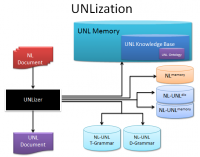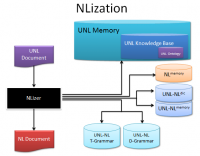UNL System
The UNL System is the set of basic modules of UNL and the rules to combine them.
Contents |
UNLization
Main article: UNLization
UNLization is the process of representing the content of a natural language structure into UNL. This process is carried out by a UNLizer. The input for the UNLizer is a natural language document or set of documents. The UNLizer first segments the natural language input according to the NL-UNL S-Grammar. Next, it tokenizes each processing unit according to the NL-UNL Dictionary and the NL-UNL Memory. The tokenization process may be controlled by the NL-UNL D-Grammar. The resulting tokenized string is then syntactically and semantically analyzed with the NL-UNL T-Grammar, which may be improved by the NL-UNL D-Grammar, the NL Memory, the UNL Memory, the UNL Knowledge Base and the UNL Ontology. The output of the process is a UNL document, which may reflect either the deep or the surface structure of the text, of each sentence or of each word of the natural language input document, depending on the structure of the grammar.
NLization
Main article: NLization
NLization is the process of generating a natural language document out of UNL. This process is carried out by a NLizer. The input for the NLization is a UNL document. The input document, which is already segmented according to the UNL Document Structure, is tokenized, according to the UNL-NL Dictionary and the UNL-NL Memory. The tokenization process may be controlled by the UNL-NL D-Grammar. The resulting tokenized string is then syntactically and semantically analyzed with the UNL-NL T-Grammar, which may be improved by the UNL-NL D-Grammar, the NL Memory, the UNL Memory, the UNL Knowledge Base and the UNL Ontology. The output of the process is a natural language document, which may reflect either the deep or the surface structure of the whole or part of the UNL input document.
Modules
- Lexical Databases
- The UNL Ontology, the UNL Knowledge Base and the UNL Memory are lists of semantic frames between UW's. These repositories include ontological relations ("a kind of" and "an instance of"), in case of UNL Ontology; necessary (ontological and thematic) relations (such as "is the agent of", "is the place where", "is the moment when"), in case of UNL Knowledge Base; and any typical relations, in case of the UNL Memory.
- The UNL<->NL Dictionary is a list of mappings between UW's and natural language entries. It is a bilingual dictionary where UW's are translated into lexical realisation units of a given natural language, and vice-versa.
- The UNL<->NL Memory is a list of mappings between UNL and natural language extracted from previous UNLizations and NLizations.
- The NL Memory is a list of syntactic frames between natural language entries.
- Grammars
- The UNL<->NL T-Grammar is the set of transformation rules used to manipulate data structures.
- The UNL<->NL D-Grammar is the set of disambiguation rules used to control the use of transformation rules.
- Tools
Specs
- Tagset
- The Tagset is a harmonized system for representing linguistic constants.
- Dictionary Specs
- The Dictionary Specs state the syntax of dictionaries.
- Grammar Specs
- The Grammar Specs state the syntax of grammar rules.
- KB Specs
- The UNL Knowledge Base Specs state the syntax of knowledge bases.
- Memory Specs
- The Memory Specs state the syntax of example bases.

